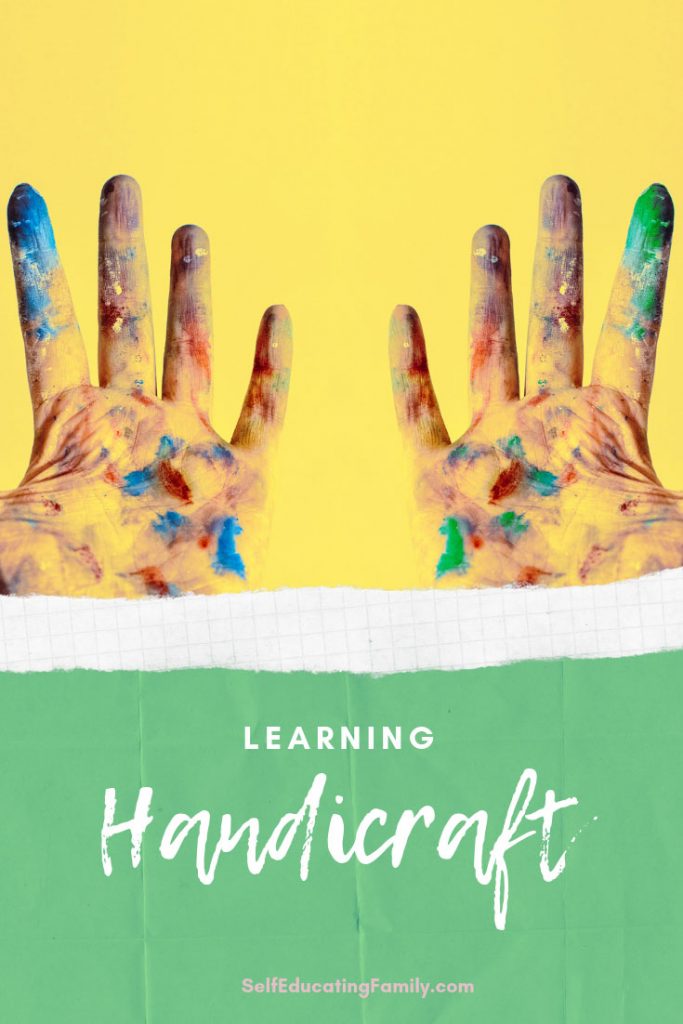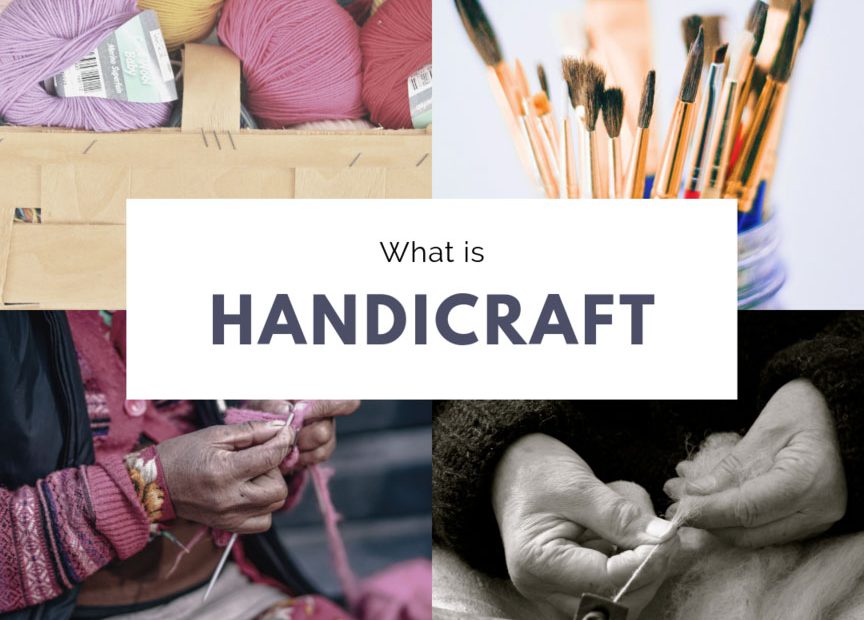DIY. Handcrafted. Artisan. What exactly is handicraft?
Definitions
In general, when we refer to handicrafts, we are talking about arts or crafts that are made by hand or by simple hand tools. Can you say “duh!”?
Crafting can be useful, practical, and beautiful. Or it can be sugar cubes glued together to form the Taj Mahal. While we’ve done our share of sugar cube creations, I’m talking about the former when I say handicrafts.
What are Charlotte Mason Handicrafts?
In the Charlotte Mason (CM) homeschooling circles, handicraft refers to teaching children to make useful things by hand. There’s an element of beauty and order to how the child should learn and do, and so, handicrafts is the application of the self towards creating something of beauty or value.
Now, I may be reading into CM’s intentions, because in the Original Home School Series, she doesn’t really mention handicrafts in detail. By the way, she wrote this “Home School” series for kids learning from their parents at home, from educators at school, and in general. “Homeschooling” as a choice in education such as we have today didn’t exist in her day, unless you’d call it “private tutoring”.
Quotes
Here’s the entire section in which she describes suitable handicrafts:
The Handicrafts best fitted for children under nine seem to me to be chair-caning, carton-work, basket-work, Smyrna rugs, Japanese curtains, carving in cork, samplers on coarse canvas showing a variety of stitches, easy needlework, knitting (big needles and wool), etc. The points to be borne in mind in children’s handicrafts are: (a) that they should not be employed in making futilities such as pea and stick work, paper mats, and the like; (b) that they should be taught slowly and carefully what they are to do; (c) that slipshod work should not be allowed; (d) and that, therefore, the children’s work should be kept well within their compass.
-Charlotte Mason Original Home School Series, Volume 1: Home Education, page 316
And in Volume 6, she says:
It is unnecessary, too, to say anything about games, dancing, physical exercises, needlework and other handicrafts as the methods employed in these are not exceptional.
-Charlotte Mason Original Home School Series, Volume 6: Towards a Philosophy of Education, page 235
So we see that while CM assumes that handicraft is essential, it does not demand the explanation or detail required in other areas of her methodology. Perhaps that is because of the times she wrote in – most children would have been schooled in “doing” various things as a natural part of their upbringing. Not a lot of TV happening in the 1890’s, and kids usually found stuff to do.
CM Summary
The things to note are:
- No twaddle (“pea and stick” work – which must be like macaroni models of the human anatomy and such.)
- No slipshod work. Attention to detail. Doesn’t she also say that it’s better to have one perfectly formed letter than a sheet of ill-formed letters?
- Choose a level that is appropriate to the child – you want to challenge them just enough, but not more than they can handle. If you pick knitting and your kiddo is 6 or 7, you’d definitely want to use those giant needles with little hands. I don’t knit, but I’ve seen the giant needles used – my mom actually tried to learn with them when she was in her 70’s. The giant needles helped her see what she was doing!
PUS and PNEU
One last note on CM and handicrafts … CM makes a mention that the Parent’s Union School programs had specifics on handicraft ideas (abbreviated PUS — what a terrible acronym!!). And upon further investigation, I found that the Parent’s National Educational Union (PNEU) had some articles in their newsletters to certain handicraft summer programs that had much success.
In the article, “Ayrshire Nature-Lore and Handicrafts Classes”(Volume 10, 1899, pg. 173), M. A. Clapperton suggests that “It is not that the work was entirely done with the hands, thus affording a rest for tired brains,” but that “the ruling idea seemed to be to put the scholar in possession of his own powers and possibilities, to help him to express freely and satisfactorily the thought that was in him.”
Handicrafts taught in times past
This particular summer program mentioned above seemed to include the following handicrafts:
- Sloyd
- Clay-modelling
- Wood-carving
- Brush-work
- Leather-embossing
- Brass-work
- Book-binding
- Basket-making
Handicraft Ideas today
Yesteryear’s handicrafts are a great place to start. But in case you aren’t ready for Sloyd, I’ve included a list of the handicrafts we’ve explored together in our co-operative group. These may help when you are searching for ideas about what type of handicraft to learn or teach today.
* Disclosure: This post contains affiliate links, meaning that if you make a purchase after clicking through, SelfEducatingFamily will receive a small commission at no extra cost to you.
List of handicraft we’ve done
- Woodcraft
- Using hammers, saws, and hand tools
- How to use power tools
- Making a flower press
- How to make a flower box
- Food preservation
- Dehydrating
- Fermenting
- Kitchen Skills
- Gardening
- Seed starting
- Garden tidying tasks
- Pruning
- Identifying local trees, herbs, and flowers
- Square Foot Gardening
- Growing sprouts
- Growing microgreens
- Qwilling
- Drawing
- For the younger set, Drawing with Children by Mona Brookes
- Drawing on the Right Side of the Brain by Betty Edwards for the older kids and the big people
- Paper crafting
- Origami
- Card Making
- Gift Tags
- DIY Bookmarks
- Napkin Folding
- Chemical Crafting
- Candlemaking
- Glass Etching
- Tin Can Luminaries
- Tye Dye Shirts
- Sculpting and Miniature painting
- Essential Oils Crafts: Making a lip balm
Still looking for more ideas?
Related articles
- Teaching Life Skills to Your Kids: What Should I Teach?
- Teaching Cooking Skills to My Kids: 6 Basic Skills Your Kid Needs
- How to select your next woodworking project to build your skills
- Essential Oils Learning Project
- Wood craft Ideas from the Guidebook to Woodworking with Kids
- Finding Good Projects to increase your woodworking skills
- Packaging cupcakes individually
Here’s a list of other websites with some good suggestions.
- Simply Charlotte Mason
- Handicrafts and Life Skills by Our Westward Journey
- 101 Handicraft links from Charlotte Mason Help
- Ideas for Non-Crafty Moms by After Thoughts
- Handicraft Ideas by Heart of Michelle
Have Fun
Hope this gives you a better idea of what is a handicraft and where to start. Have fun as you learn some new handicrafts.

